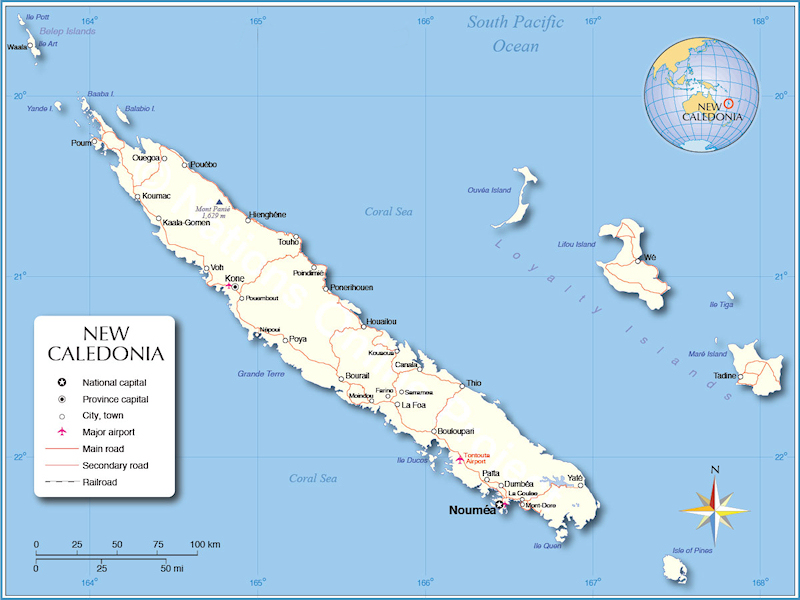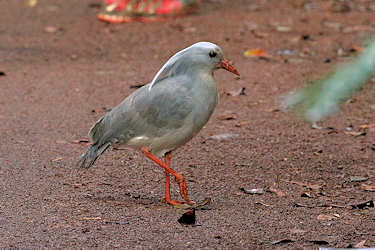New Caledonia

Historie
The earliest traces of human presence in New Caledonia date back to the Lapita period; dating from about
1200 BCE to 500 BCE. The Lapita were perhaps the most advanced people of their day in seamanship and navigation,
reaching out and finding islands separated from each other by hundreds of miles of empty ocean. Their descendants,
the Polynesians, would populate islands from Hawaii to Easter Island, possibly even reaching the South
American continent.
British explorer Captain James Cook was the first European to sight New Caledonia, on 4 September 1774, during
his second voyage. He named it "New Caledonia", as the north-east of the island reminded him of Scotland.
The west coast of Grande Terre was approached by Jean-François de Galaup, comte de Lapérouse in 1788, shortly
before his disappearance in a cyclone on the reefs off Vanikoro in the souteast of the Solomon Islands.
The Loyalty Islands, incidentally, owe their title not to Cook but to the wonderfully named Jethro Daggett,
master of the London ship Loyalty who saw them on a 1790 trading voyage.
British and American whalers were the first commercial seafarers to make landfall on the islands. By 1840 British
whalers set up an oil-extraction station on Lifou, the largest of the Loyalty Islands.
Next came sandelwood traders, who were the first Europeans to have any real impact on the islanders. Sandelwood
was traditionally burnt as incense in Chinese temples. Between 1840 and 1850, traders operating out of Australia almost
completely stripped firts Isle des Pins, then the Loyalty Islands and finally Grand Terre's east coast.
As trade in sandalwood declined, it was replaced by a new form of trade, "blackbirding", a euphemism for
enslaving people from New Caledonia, the Loyalty Islands, New Hebrides, New Guinea, and the Solomon Islands to work
in sugarcane plantations in Fiji and Queensland. The trade ceased at the start of the 20th century. The victims of
this trade were called 'Kanakas' like all the Oceanian people, after the Hawaiian word for 'man'.
On 24 September 1853, under orders from Napoleon III, Admiral Febvrier Despointes took formal
possession of New Caledonia and Port-de-France (Nouméa) was founded 25 June 1854.
New Caledonia became a penal colony, and from the 1860s until the end of the transportations in 1897, about
22.000 criminals and political prisoners were sent to New Caledonia. Between 1873 and 1876, 4.200 political
prisoners were "relegated" in New Caledonia. Only 40 of them settled in the colony; the rest returned to France
after being granted amnesty in 1879 and 1880
In March 1942, with the assistance of Australia, the territory became an important Allied base, and Nouméa the
headquarters of the United States Navy and Army in the South Pacific. The fleet which turned back the Japanese
navy in the Battle of the Coral Sea in May 1942 was based at Nouméa.
In 1946, New Caledonia became an french overseas territory. By 1953, French citizenship had been granted to all
New Caledonians, regardless of ethnicity.
The Noumea Accord signed 5 May 1998, set the groundwork for a 20-year transitional period that will
gradually transfer competences to the local government.
On 20 March 2018, the government announced a referendum that was held on 4 November 2018, with independence being rejected.
Another referendum was held October 2020 and voters once again voted to remain a part of France
I have visited New Caledonia in april 2015.
It was part of the West Pacific Odessey
On that trip i have seen
Nouméa
Please let me know when you're having questions.
i would be pleased to help you.
Things to do and other tips
